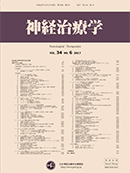39 巻, 4 号
選択された号の論文の108件中1~50を表示しています
-
2022 年 39 巻 4 号 p. 423-428
発行日: 2022年
公開日: 2022/12/27
PDF形式でダウンロード (454K)
第39回日本神経治療学会学術集会特集2
教育講演
-
2022 年 39 巻 4 号 p. 429
発行日: 2022年
公開日: 2022/12/27
PDF形式でダウンロード (139K) -
2022 年 39 巻 4 号 p. 430-434
発行日: 2022年
公開日: 2022/12/27
PDF形式でダウンロード (777K) -
2022 年 39 巻 4 号 p. 435-438
発行日: 2022年
公開日: 2022/12/27
PDF形式でダウンロード (1436K) -
2022 年 39 巻 4 号 p. 439-443
発行日: 2022年
公開日: 2022/12/27
PDF形式でダウンロード (398K) -
2022 年 39 巻 4 号 p. 444-446
発行日: 2022年
公開日: 2022/12/27
PDF形式でダウンロード (353K) -
2022 年 39 巻 4 号 p. 447
発行日: 2022年
公開日: 2022/12/27
PDF形式でダウンロード (196K) -
2022 年 39 巻 4 号 p. 448-452
発行日: 2022年
公開日: 2022/12/27
PDF形式でダウンロード (1019K) -
2022 年 39 巻 4 号 p. 453-457
発行日: 2022年
公開日: 2022/12/27
PDF形式でダウンロード (1828K) -
2022 年 39 巻 4 号 p. 458
発行日: 2022年
公開日: 2022/12/27
PDF形式でダウンロード (191K)
シンポジウム9:非定型パーキンソニズムの臨床;update 2021
-
2022 年 39 巻 4 号 p. 459
発行日: 2022年
公開日: 2022/12/27
PDF形式でダウンロード (244K) -
2022 年 39 巻 4 号 p. 460-463
発行日: 2022年
公開日: 2022/12/27
PDF形式でダウンロード (514K) -
2022 年 39 巻 4 号 p. 464
発行日: 2022年
公開日: 2022/12/27
PDF形式でダウンロード (184K) -
2022 年 39 巻 4 号 p. 465-467
発行日: 2022年
公開日: 2022/12/27
PDF形式でダウンロード (336K) -
2022 年 39 巻 4 号 p. 468-471
発行日: 2022年
公開日: 2022/12/27
PDF形式でダウンロード (541K) -
2022 年 39 巻 4 号 p. 472-476
発行日: 2022年
公開日: 2022/12/27
PDF形式でダウンロード (747K)
シンポジウム10:遺伝子診療のホットトピックス
-
2022 年 39 巻 4 号 p. 477
発行日: 2022年
公開日: 2022/12/27
PDF形式でダウンロード (176K) -
2022 年 39 巻 4 号 p. 478-483
発行日: 2022年
公開日: 2022/12/27
PDF形式でダウンロード (1227K) -
2022 年 39 巻 4 号 p. 484-488
発行日: 2022年
公開日: 2022/12/27
PDF形式でダウンロード (417K) -
2022 年 39 巻 4 号 p. 489-494
発行日: 2022年
公開日: 2022/12/27
PDF形式でダウンロード (555K) -
2022 年 39 巻 4 号 p. 495-499
発行日: 2022年
公開日: 2022/12/27
PDF形式でダウンロード (2774K)
シンポジウム11:脳梗塞急性期治療のパラダイムシフト
-
2022 年 39 巻 4 号 p. 500
発行日: 2022年
公開日: 2022/12/27
PDF形式でダウンロード (258K) -
2022 年 39 巻 4 号 p. 501-505
発行日: 2022年
公開日: 2022/12/27
PDF形式でダウンロード (981K) -
2022 年 39 巻 4 号 p. 506-509
発行日: 2022年
公開日: 2022/12/27
PDF形式でダウンロード (752K) -
2022 年 39 巻 4 号 p. 510-513
発行日: 2022年
公開日: 2022/12/27
PDF形式でダウンロード (344K) -
2022 年 39 巻 4 号 p. 514-516
発行日: 2022年
公開日: 2022/12/27
PDF形式でダウンロード (457K) -
2022 年 39 巻 4 号 p. 517-521
発行日: 2022年
公開日: 2022/12/27
PDF形式でダウンロード (633K)
シンポジウム12:難治性ニューロパチーの新規治療への展望
-
2022 年 39 巻 4 号 p. 522
発行日: 2022年
公開日: 2022/12/27
PDF形式でダウンロード (263K) -
2022 年 39 巻 4 号 p. 523
発行日: 2022年
公開日: 2022/12/27
PDF形式でダウンロード (186K) -
2022 年 39 巻 4 号 p. 524
発行日: 2022年
公開日: 2022/12/27
PDF形式でダウンロード (204K) -
2022 年 39 巻 4 号 p. 525
発行日: 2022年
公開日: 2022/12/27
PDF形式でダウンロード (193K) -
2022 年 39 巻 4 号 p. 526-529
発行日: 2022年
公開日: 2022/12/27
PDF形式でダウンロード (411K)
シンポジウム13:神経筋疾患の核酸医薬による治療戦略の最前線
-
2022 年 39 巻 4 号 p. 530
発行日: 2022年
公開日: 2022/12/27
PDF形式でダウンロード (273K) -
2022 年 39 巻 4 号 p. 531
発行日: 2022年
公開日: 2022/12/27
PDF形式でダウンロード (196K) -
2022 年 39 巻 4 号 p. 532-534
発行日: 2022年
公開日: 2022/12/27
PDF形式でダウンロード (405K) -
2022 年 39 巻 4 号 p. 535-538
発行日: 2022年
公開日: 2022/12/27
PDF形式でダウンロード (443K) -
2022 年 39 巻 4 号 p. 539
発行日: 2022年
公開日: 2022/12/27
PDF形式でダウンロード (212K) -
2022 年 39 巻 4 号 p. 540
発行日: 2022年
公開日: 2022/12/27
PDF形式でダウンロード (220K)
シンポジウム14:神経救急における脳神経内科医の役割
-
2022 年 39 巻 4 号 p. 541
発行日: 2022年
公開日: 2022/12/27
PDF形式でダウンロード (231K) -
2022 年 39 巻 4 号 p. 542-545
発行日: 2022年
公開日: 2022/12/27
PDF形式でダウンロード (535K) -
2022 年 39 巻 4 号 p. 546-549
発行日: 2022年
公開日: 2022/12/27
PDF形式でダウンロード (948K) -
2022 年 39 巻 4 号 p. 550
発行日: 2022年
公開日: 2022/12/27
PDF形式でダウンロード (152K) -
2022 年 39 巻 4 号 p. 551
発行日: 2022年
公開日: 2022/12/27
PDF形式でダウンロード (179K) -
2022 年 39 巻 4 号 p. 552
発行日: 2022年
公開日: 2022/12/27
PDF形式でダウンロード (192K)
シンポジウム15:神経疾患における睡眠障害とその対策
-
2022 年 39 巻 4 号 p. 553
発行日: 2022年
公開日: 2022/12/27
PDF形式でダウンロード (229K) -
2022 年 39 巻 4 号 p. 554-557
発行日: 2022年
公開日: 2022/12/27
PDF形式でダウンロード (743K) -
2022 年 39 巻 4 号 p. 558
発行日: 2022年
公開日: 2022/12/27
PDF形式でダウンロード (216K) -
2022 年 39 巻 4 号 p. 559-563
発行日: 2022年
公開日: 2022/12/27
PDF形式でダウンロード (903K) -
2022 年 39 巻 4 号 p. 564-568
発行日: 2022年
公開日: 2022/12/27
PDF形式でダウンロード (1971K) -
2022 年 39 巻 4 号 p. 569
発行日: 2022年
公開日: 2022/12/27
PDF形式でダウンロード (202K)
